Cherie Magnus's Blog, page 2
March 16, 2014
Tango Angeles: Tangocherie's Interview on the Only English-Language Tango Radio Program!

Recently I had the pleasure of being interviewed by radio host and tango DJ Ronaldo on his ground-breaking live radio broadcast and podcast of Tango Angeles on the Universal Broadcasting Network at the historic Sunset-Gower Studios in Hollywood. In between carefully selected recorded music, I answered questions about visiting Buenos Aires (and my tips for a great tango trip), my personal life journey that I related in my memoir, The Church of Tango, and my own story of Ruben's and my "Love in the Space of a Song," one in a continuing series on the program. There was also time to mention my new memoir due to be released soon, Arabesque: Dancing on the Edge in Los Angeles, as well as discussing the ever-controversial codigos and other tango topics.
It was an honor and a privilege to be on the show, the only English-language radio program, which airs every other week on Wednesdays at 6:00-8:00 p.m. Pacific Time. You can download the free podcasts of previous shows here from.iTunes. In between the chatting, Ronaldo plays some fantastic music and explains interesting points about the piece, orchestra, composer, and/or singer.
Meanwhile you can be part of the Tango Angeles community no matter where you live by liking its Facebook page.
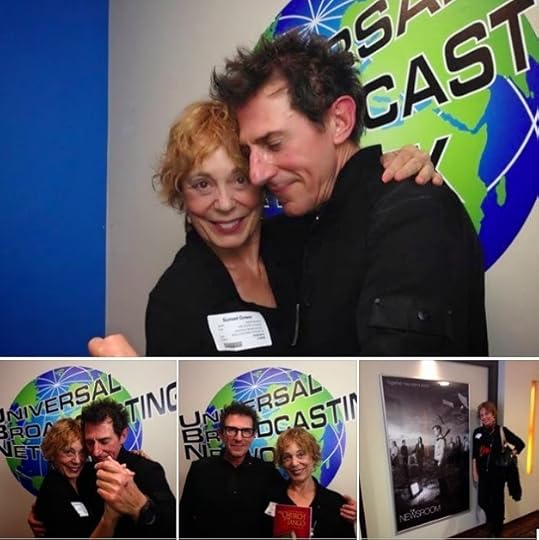
Published on March 16, 2014 12:00
Tango Angeles: Tangocherie's Interview on the First English-Language Tango Radio Program!

Recently I had the pleasure of being interviewed by radio host and tango DJ Ronaldo on his ground-breaking live radio broadcast and podcast of Tango Angeles on the Universal Broadcasting Network at the historic Sunset-Gower Studios in Hollywood. In between carefully selected recorded music, I answered questions about visiting Buenos Aires (and my tips for a great tango trip), my personal life journey that I related in my memoir, The Church of Tango, and my own story of Ruben's and my "Love in the Space of a Song," one in a continuing series on the program. There was also time to mention my new memoir due to be released soon, Arabesque: Dancing on the Edge in Los Angeles, as well as discussing the ever-controversial codigos and other tango topics.
It was an honor and a privilege to be on the show, the only English-language radio program, which airs every other week on Wednesdays at 6:00-8:00 p.m. Pacific Time. You can download the free podcasts of previous shows here from.iTunes. In between the chatting, Ronaldo plays some fantastic music and explains interesting points about the piece, orchestra, composer, and/or singer.
Meanwhile you can be part of the Tango Angeles community no matter where you live by liking its Facebook page.

Published on March 16, 2014 12:00
January 22, 2014
Carnaval en Gualeguaychu 2014
 The first float in O'Bahia's "Homo Ludens" or TOYS--see the acrobats twirling in the blue circles?
The first float in O'Bahia's "Homo Ludens" or TOYS--see the acrobats twirling in the blue circles?There's nothing like it, folks! You haven't seen everything if you haven't been to Carnaval (Carnival) in Gualeguaychu, Entre Rios, Argentina.
Maybe you think it's like a parading Las Vegas show--almost naked girls in feathers marching with the occasional float, or like in Rio de Janeiro--highly commercialized floats and feathers, or New Orleans with its jazz and black culture roots. But El Carnaval del Pais en Gualeguaychu is a unique experience and well-worth a visit.
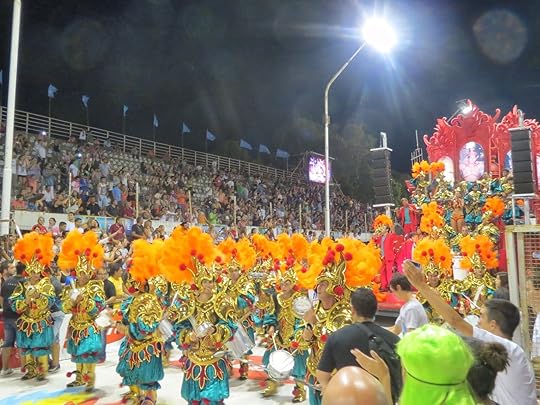
What I love most is seeing all of those feathers bouncing and boppin' up and down, and the floats too bounce with all the dancers on them. You can't help but be happy. The head and back pieces are enormously heavy, but the dancers dance! It's amazing. Kids constantly run through the groups giving gulps of water to everyone as they dance away. It was very hot on Saturday, January 18, when we were there, but even in heavy costumes (not all are semi-naked) they danced with great energy, vigor, and personality. The people in the bleachers dance right along, often standing on their chairs. The dancers often pose for photos with the audience. It is all very infectious.
But I also love the messages and stories.
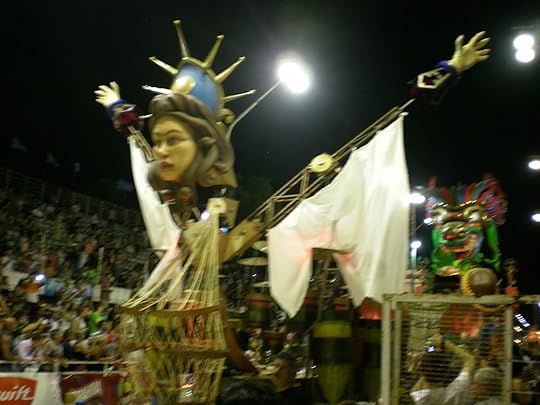 The arrival of the Conquistadores
The arrival of the ConquistadoresAt first glance it may appear it's all about girls and fun, but it is way more than that. Each comparsa, or club, has a theme and chances are the dark side is included. In fact, it's tradition that the devil is always a participant. The three comparsas that compete in 2012 are O'Bahia -- "Toys," Kamarr -- "Q.E.P.D." or R.I.P., begins with a funeral dirge for Momo, the king of fun who has been buried with dancing skeletons and zombies. Let's inter all the evil in history and bring back the joy of Carnaval! And the Papelitos--"Latidos," the rape of the Americas by Europe and the killing of the land by mechanization and commercialization--kinda heavy stuff--but so entertaining with all those feathers and dancing jaguars and trees and a ghost ship.

You are distracted by all the craziness and bodies, and then something or someone passes by and you are suddenly hit upside the heart.

The floats are gigantic, pushed by tractors, and you wonder how they can navigate the narrow path with just inches to spare on either side. The smaller "floats" are pushed by one or two people.
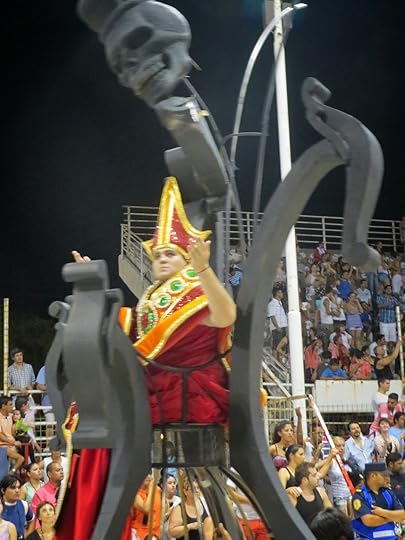 The Church as killjoy (pushed by one man)
The Church as killjoy (pushed by one man)2014 was our fourth time at Carnaval. Our first was in 2005, a turn-around trip in a small van (not recommended), when Ruben had a gallbladder attack on the way back to BsAs and someone else was drunk.
But the Carnaval part of the excursion was so fabulous that we made plans to go back a year or two later. This time we did it right and stayed in the loveliest place in town, next to the Rio Gualeguaychu and with the most beautiful swimming pool. You can also go in the spur of the moment and rent a room for the night from one of the many locals who hawk their homes on street corners.
 La Posada del Puerto
La Posada del PuertoThe pretty little town full of very old buildings and 19th century architecture is a pleasant treeful and green place to walk and admire the full moon rising over the river. Even though the town hosts this extravaganza every year, there isn't a commercial atmosphere. One feels safe, as there is lots of security about, but the attitude is kind and hospitable without the drunken rudeness that often accompanies mass festivals and events. The town and the Carnaval are very family friendly.
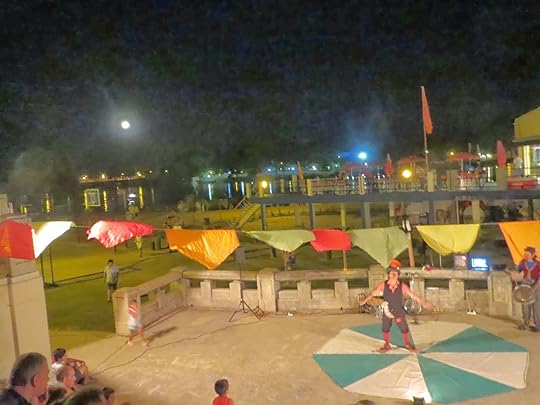 Moon rise over the river while juggler juggles
Moon rise over the river while juggler jugglesEvery Saturday in January and February, and the first Saturday in March, Carnaval takes place in the Corsodromo behind the antique railway station, with a parade of three "comparsas" (carnaval clubs) competing for the grand prize, the comparsas parade the 550 meter length of the Corsodromo for an hour each. (My advice: sit at the beginning in the first sectors to eliminate much of the waiting and to finish earlier.) It begins around ten or ten-thirty but go early and eat at one of the many parrillas on the grounds or if you sit in the Sector VIP you get table service.
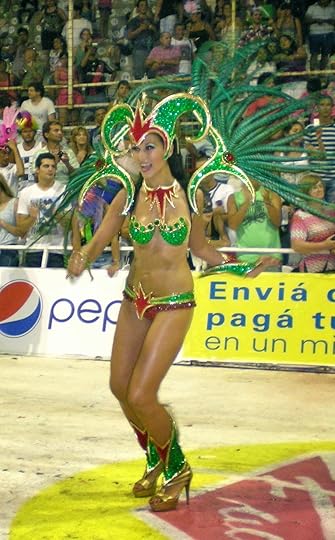
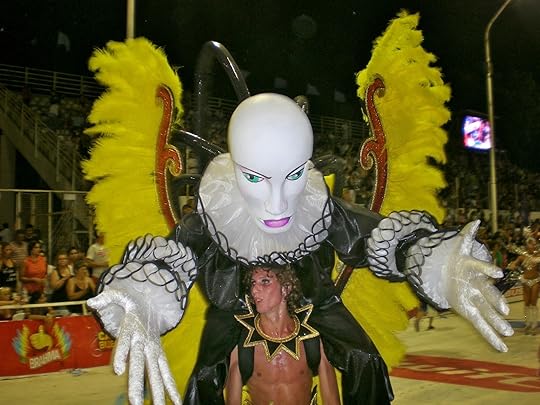
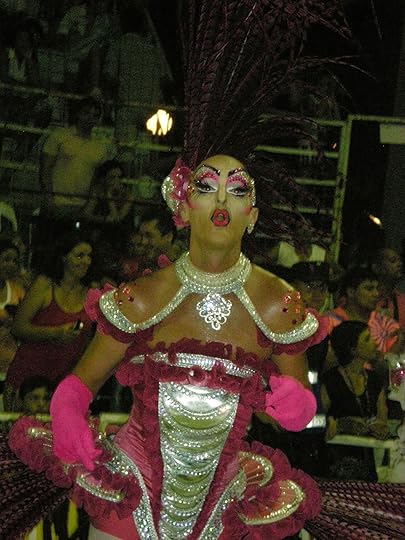

Each comparsa includes over 300 dancers, and is accompanied by 4 huge floats, a drum band (batucada) and a singing band. Each club chooses a theme and a theme song, and the theme is brought to life using the floats, costumes, decorations and songs and thousands of feathers. You can read more here.
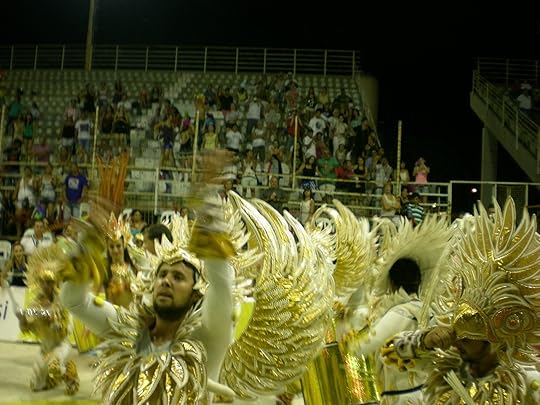 The Batucada of Papelitos
The Batucada of PapelitosThis year my vote goes to the Papelitos for their political statement and the best batucada group of drummers and pasissta (lead dancer) ever, but I loved it all. I was going to include a video from YouTube, but a video can't begin to show the extent of the frivolity, imagination, and deep thought and talent that goes into each comparsa.
And let's not forget the incredible live bands of each comparsa with their own singers!
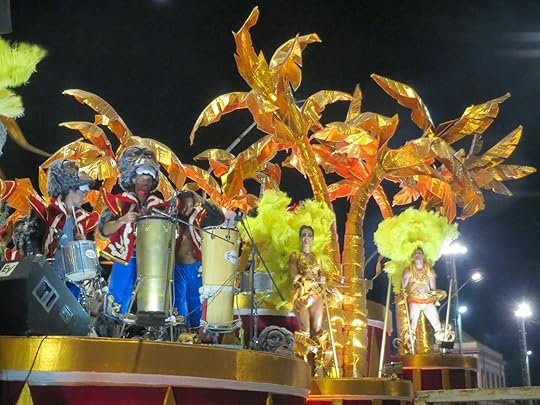 O'Bahia's band
O'Bahia's bandNo se mata la alegria, viva el carnaval
Resucita Momo y hay que festejar
No se acaba la alegria todos a cantar
bombo y serpentina que llego Kamarr!
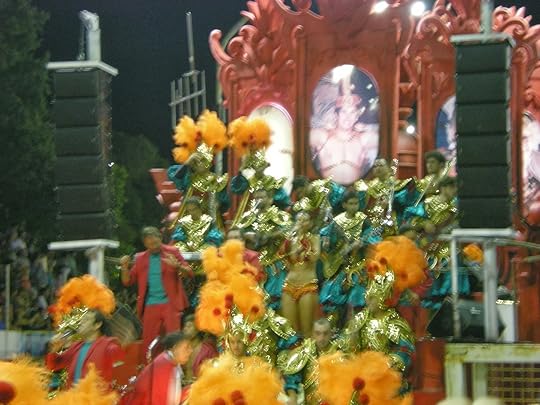 Kamarr's band
Kamarr's bandSe oye el latir (mi grito) de esta tierra (mi sangre),
Tierra latinoamericana (Papelitos)
Read about our experience at Carnaval 2011 here.
Viva el Carnaval!
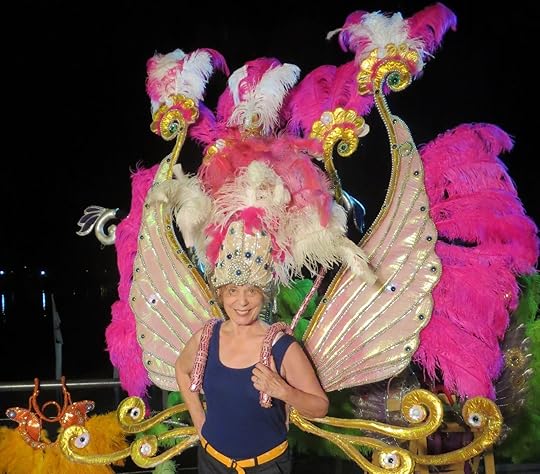 tangocherie
tangocherie
Published on January 22, 2014 03:17
December 8, 2013
FREE Download B.A. Tango, Nov.2013 thru Feb. 2014
Published on December 08, 2013 04:18
September 24, 2013
Trauma to Tango, Aydan Dunnigan's Memoir
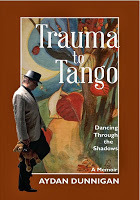 The following is the chapter on a trip to Buenos Aires from Aydan Dunnigan's memoir,
Trauma to Tango
. The book is a spiritual and psychological quest for wholeness after a childhood of abuse and a lifetime of floundering. He caroms from a Baptist youth to Born Again to being a Lutheran Pastor to a New Ager. The author uses tango as a metaphor, it is not the subject of the memoir. But this charming chapter is fun reading for anyone who has visited Buenos Aires to dance.Our friends from the Edmonton tango community, Geoff and Susan, world travellers, had assured us that we could get by comfortably in Buenos Aires on $20 a day and a por favor. Always suckers for a good deal, we packed up our tango shoes and our Spanish-English phrase dictionary and set off on a pilgrimage to the Mecca of our new found religion. Twenty-four hours later, only slightly maimed, we hobbled off the plane into the mystical world of dance and romance, thrilled at the prospect of conquering a foreign culture and putting our tango expertise to the test.
The following is the chapter on a trip to Buenos Aires from Aydan Dunnigan's memoir,
Trauma to Tango
. The book is a spiritual and psychological quest for wholeness after a childhood of abuse and a lifetime of floundering. He caroms from a Baptist youth to Born Again to being a Lutheran Pastor to a New Ager. The author uses tango as a metaphor, it is not the subject of the memoir. But this charming chapter is fun reading for anyone who has visited Buenos Aires to dance.Our friends from the Edmonton tango community, Geoff and Susan, world travellers, had assured us that we could get by comfortably in Buenos Aires on $20 a day and a por favor. Always suckers for a good deal, we packed up our tango shoes and our Spanish-English phrase dictionary and set off on a pilgrimage to the Mecca of our new found religion. Twenty-four hours later, only slightly maimed, we hobbled off the plane into the mystical world of dance and romance, thrilled at the prospect of conquering a foreign culture and putting our tango expertise to the test.Although no longer navigable at $20 per day, BA still remained quite a tourist bargain and we were enthralled with the elaborate architecture, the extravagant European craftsmanship, the plenitude of parks and roads that spread out forever, (one street, 32 lanes!). Getting around should have been easy with taxis outnumbering private vehicles, fares dirt cheap and drivers courteous and honest (although they all drove like Jaun Fangio wannabes).
The real challenge came in the communication. Our dusty old dictionary was just not up to the task, nor were we. Perhaps we travelled in different circles than our friends, but a por favor just would not cut it. Here in San Telmo, the heart of tango and a very authentic Argentine neighbourhood, English was as distant as a plate of salad greens in a parilla (a restaurant with a BBQ spit in the middle – a popular Argentine venue). The little Spanish we knew was apparently from some other continent and bore no familiarity to the street dialect and the distinctive Argentine Castellano, which often left us stuck on a street corner, not knowing how to ask directions, or standing stupified in front of a vendor with a line-up behind, haplessly trying to count out an undeciphered amount of change.
It was downhill from there. Before we had left Edmonton, I had made great pains to ensure that I would have email contact with my teens when I was away, so I had purchased a little laptop and brought along the proper power adaptors. One minor miscalculation. In Buenos Aires no one has home email. This is theoretically not a problem because at every street corner there is a telecommun-ications cafe that has phone service and internet access except that the Spanish keyboard is different and no matter what combination of keys I pressed I could not get the @ key to appear in my email address line. The shop owner apparently couldn’t understand my dilemma or didn’t care as I sat pathetically staring at a room full of computers and not able to use one of them. I was heartbroken.
Plan two: Call the only people we knew in Argentina who spoke English, our friends in Patagonia whom we were meeting later on in our trip. When I lifted the receiver, instead of a dial tone I got a thirty second taped message of more Castellano Spanish. Back to the desk clerk I went with the phone number in hand and asked him to dial. He had no more success than I did. Apparently the phone system was as unnavigable as the internet, even to the locals. (In truth, I don’t recall anyone having much more success with the phone system dialing out of region; there seemed to be a complicated series of codes that had to be cracked like the combination on a lock.)
I walked out a broken man, 10,000 miles from home with no way to make contact with anyone I loved or who cared about me. If we were to be mugged by a taxi driver and dropped off the end of a pier, (which we feared was going to happen at one point), no one would be any the wiser.
Off we went in search of a place to regain our composure, perhaps a quiet cafe for a good cup of coffee and some solitude. We were met at the door of a quaint out-of-the-way establishment by an elderly, elegantly dressed woman who greeted us formally in the textbook Spanish - the same Spanish that I had been studying for months prior but to this point had never been able to use. This was a homecoming! Someone whom we understood! The feeling was so overwhelming I walked in, went over into the corner and crumbled into a weeping, convulsing blob. Afraid that my hysteria might be contagious, Patricia and our proper, well-spoken host pulled away into the other room to address the task of ordering some coffee. As it turned out, this was not in fact a coffee shop but rather a chocolateria, with coffee merely a chaser for chocolates.
“No, no, we don’t want chocolates,” Patricia tried to explain, as we had been on a three day diet of meat and cheese, (the only menu item we knew how to order, served everywhere all the time). Her protestations were interpreted as wanting more chocolates and merely incited the woman’s eagerness to satisfy us. In desperation Patricia pulled out her dictionary with her spare hand, the other one carefully balancing the saucer of chocolates and coffee, and tried to find some phrases about ordering food. The only phrase she could come up with in our pathetically inadequate phrase dictionary was, “I would like to start with the onion soup, please.”
Pitching the dictionary, Patricia committed both hands to managing more chocolates while I slowly recovered from my convulsions in the corner and returned to normalcy. Apparently the emotional release was cathartic and after washing down our sweets with a shot of espresso we were ready to face the day again.
The agenda for that day was to make it to a milonga (tango dance). We had thoroughly researched the wheres and whens before we left Edmonton so again, presumably, we were well prepared. Not far from our residence was the Confiteria Ideal with the marble floor and pillars that often appear as a foil for the glitz of tango movies. Dressed theatrically in our dancing attire and pesos, maps and brochures in hand, we headed out onto to the street corner to flag down a taxi and direct him to our destination.Another minor miscalculation. It was Sunday in Buenos Aires: there were huge political protests going on in the city centre. En route to our destination the traffic came to a complete halt. As our driver could take us no further we were asked for the fare and politely instructed to get out. Between us and our destination was a 30 lane highway, a park and a thick mob of protesters. Off we trekked dressed in our tango finery, Patricia balancing precariously in her high-heeled heels, and I in my Carlos Gardel fedora, trying to look as inconspicuous as two penguins.
By the time we made it to the Confiteria our shoes were muddied, we were exhausted, and our tango luster had thoroughly faded. Patricia, whose feet had been troubling her earlier, now was in no condition to be dancing. We plunked ourselves down at one of the tables and resigned ourselves to being spectators. After a seemingly interminable period of sitting on the sidelines, I determined that I was going to get in on the action. Since my partner was out of commission, this meant I was going to have to ply my trade on the open market and wade into the sea of experienced local dancers.Tango etiquette, which I had properly researched, included numerous cultural anachronisms, all seemingly designed to protect the males inflated but fragile ego. One such customs was, if you wanted to dance with someone, you eyed her from across the room. If she reciprocated with eye contact it indicated that she was interested in your offer. In this discrete manner, a woman would gracefully accept or rebut a man’s offer without anyone else being any the wiser. The problem was that, without my glasses, I could barely determine the sex of a person from across the room, let alone whether she (or he) was returning eye contact.
I did exactly what any culturally insensitive, boorish Canadian would do in that circumstance. I brashly paraded down the sidelines and started propositioning the women who weren’t dancing. I was not one of those machismo Argentine tangeros who could not deal with rejection. I took blow after blow directly to the ego but continued to proceed down this line until, at the very end, an elderly woman with pink hair took pity on me.
Up we went on to the floor. After only a few steps into the dance this poor maligned woman began screaming at me, in Spanish of course. I had no clue what she was upset about and began vehemently defending myself in English, of which she couldn’t understood a word. I became desperate. My training in tangero folklore had made clear that if a woman walked out on you in the middle of a dance, I as a proper tangero, totally humiliated, would have to go out back and stab myself. (All tango violence is knife inflicted. They like their knives more than their lives.) So in the middle of the dance, in the centre of the dance floor we are squared off, she infuriated, I desperately pleading as if for my life. Fortunately she stuck the dance out and I lived to tell. Returning to the table devastated, Patricia attempted to console me, “At least you had the nerve to try.”
OK. Now we are at a serious impasse. I could accept the language barrier and that we could not be understood well enough to order a proper coffee without chocolates or something other than a plate of meat and cheese, but to not be understood on the dance floor with the universal language of dance was too much for me to come to terms with. Something was seriously askew. We needed help.The next day our agenda was adjusted to include more tango lessons. Our host was also, conveniently, a dance instructor, so we booked a session. We showed her our stuff, fitting in all the kicks and pivots and spins we could manage, then stopped to accept praise.
Her muted compliment, “Well you sure know a lot of steps.” Another but. “But you are lacking in an energy connection.” She then wafted into an esoteric explanation about how we were to envision this ball of light between us which would guide and empower the dance. Patricia got all excited as this energy stuff apparently makes perfect sense to her. For me it was more confusing that the pink-haired lady screaming Spanish to me in the middle of the dance floor. See the energy, feel the energy. I come up short again. Apparently all that learning, all those lessons, amounted to nothing because I could not get the energetic connection. I was back on the dance floor at La Boheme desperately trying to be right here and not in front of myself or behind myself.
I start pulling threads together. Breathing, sensing the energy, leading with the chest, they all orbit around the heart chakra. I had been doing my classic disconnect, splitting my physicality into what happens from the waist down and the neck up and leaving the heart out of it altogether. According to this teacher, and contrary to the tango folklore, tango is not about studly men and slutty women doing sultry, seductive steps. It is all about the heart, the key element that I have been understandably, quite reluctant to embrace. Tango is a dance of love.
Am I up for this? Certainly love factors heavily into Patricia’s and my dance experience, (as it does with most everything we engage in). But to unabashedly parade my affections out onto the dance floor to share it indiscriminately with whomever my dance partner happens to be?
This question follows me deep into the night. As I drift into the Land of Nod familiar voices started up in conversation.
Published on September 24, 2013 06:01
August 22, 2013
FREE Download: B.A. Tango Magazine #215 July, August, Sept., Oct 2013
DESDE 1995 LA PRIMERA DE LAS REVISTAS DE ACTUALIDAD TANGUERA SINCE 1995 THE FIRST OF THE CURRENT EVENTS TANGO MAGAZINE Bailo, luego existo I Dance, Therefore I Am Carlos Medrano Jimena Hoeffner Fernando Carrasco Entrevistas
In 3 parts for better graphic quality.
BATango Nº 215 Part 1 by Cherie Magnus
BATango Nº 215 Part 2 by Cherie Magnus
BATango Nº 215 Part 3 by Cherie Magnus
In 3 parts for better graphic quality.
BATango Nº 215 Part 1 by Cherie Magnus
BATango Nº 215 Part 2 by Cherie Magnus
BATango Nº 215 Part 3 by Cherie Magnus
Published on August 22, 2013 05:28
FREE Download: B.A. Tango Magazine #215 Part 1 July, August, Sept., Oct 2013
DESDE 1995 LA PRIMERA DE LAS REVISTAS DE ACTUALIDAD TANGUERA SINCE 1995 THE FIRST OF THE CURRENT EVENTS TANGO MAGAZINE Bailo, luego existo I Dance, Therefore I Am Carlos Medrano Jimena Hoeffner Fernando Carrasco Entrevistas
In 3 parts for better graphic quality.
BATango Nº 215 Part 1 by Cherie Magnus
BATango Nº 215 Part 2 by Cherie Magnus
BATango Nº 215 Part 3 by Cherie Magnus
In 3 parts for better graphic quality.
BATango Nº 215 Part 1 by Cherie Magnus
BATango Nº 215 Part 2 by Cherie Magnus
BATango Nº 215 Part 3 by Cherie Magnus
Published on August 22, 2013 05:28
May 14, 2013
B.A. Tango #214 Quarterly Magazine Free Download
The magazine is in three parts for better graphic quality.
B.A. Tango #214 Part 1 by Cherie Magnus
B.A. Tango #213 Part 2 by Cherie Magnus
B.A. Tango #-214l Part3
B.A. Tango #214 Part 1 by Cherie Magnus
B.A. Tango #213 Part 2 by Cherie Magnus
B.A. Tango #-214l Part3
Published on May 14, 2013 05:09
May 12, 2013
"One Tango Moment"
Carla Thackrah followed the Australian tango champions to Buenos Aires where they competed in the Tango Championships of 2007. Along the way they all learned what tango is in Buenos Aires--and what it isn't. There is footage of their practice, their time in local milongas, interviews (Ruben and I are in there dancing and speaking as well), and their final competition performance. Kudos to Carla for an excellent documentary well worth a watch for anyone curious about the tango in Buenos Aires. If you've danced here before, you'll probably see people you know in the milonga scenes.
"Federico and Hosanna are Australia's tango champions. In August 2007, they travelled to Buenos Aires to compete, along with 479 couples from 154 different cities around the world, for the title of Tango World Champion. When they arrive in Buenos Aires, all their preconceived ideas about tango are challenged... tango is not just about learning a choreography, it is inextricably linked to a far deeper culture. Producer, director, writer, cinematographer - Carla Thackrah"
"Federico and Hosanna are Australia's tango champions. In August 2007, they travelled to Buenos Aires to compete, along with 479 couples from 154 different cities around the world, for the title of Tango World Champion. When they arrive in Buenos Aires, all their preconceived ideas about tango are challenged... tango is not just about learning a choreography, it is inextricably linked to a far deeper culture. Producer, director, writer, cinematographer - Carla Thackrah"
Published on May 12, 2013 22:40
March 31, 2013
My Big Fat Birthday 2013
A grand and exciting night for me! I am so very grateful to all the friends and students from all around the world who came to La Milonga de los Consagrados to help me celebrate and make my birthday so special!
If you just want to see us dance, skip to the bottom.
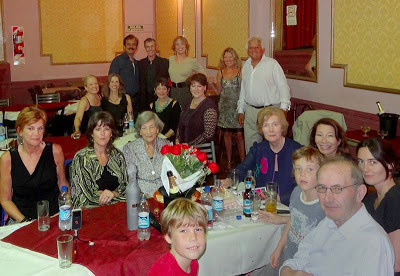
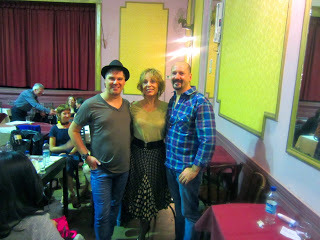
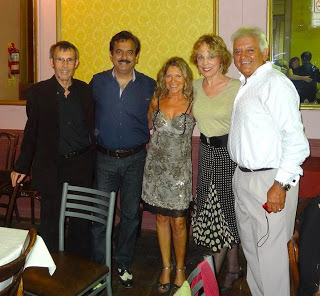
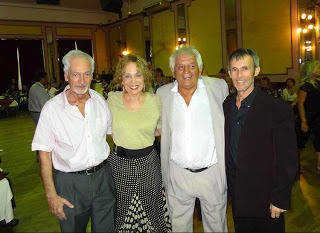
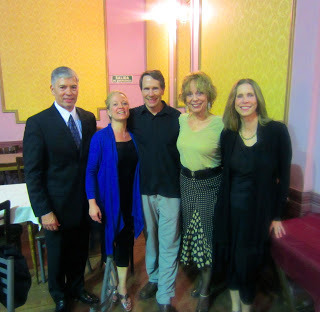


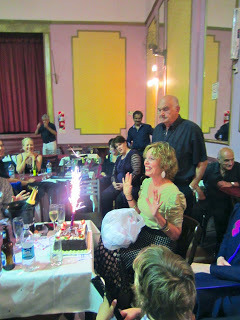
Ruben and I danced to D'Arienzo's "El Rey"
Our Canaro milonga "encore"
And, if you can stand a couple minutes more, here's a chacarera:
Published on March 31, 2013 08:26



